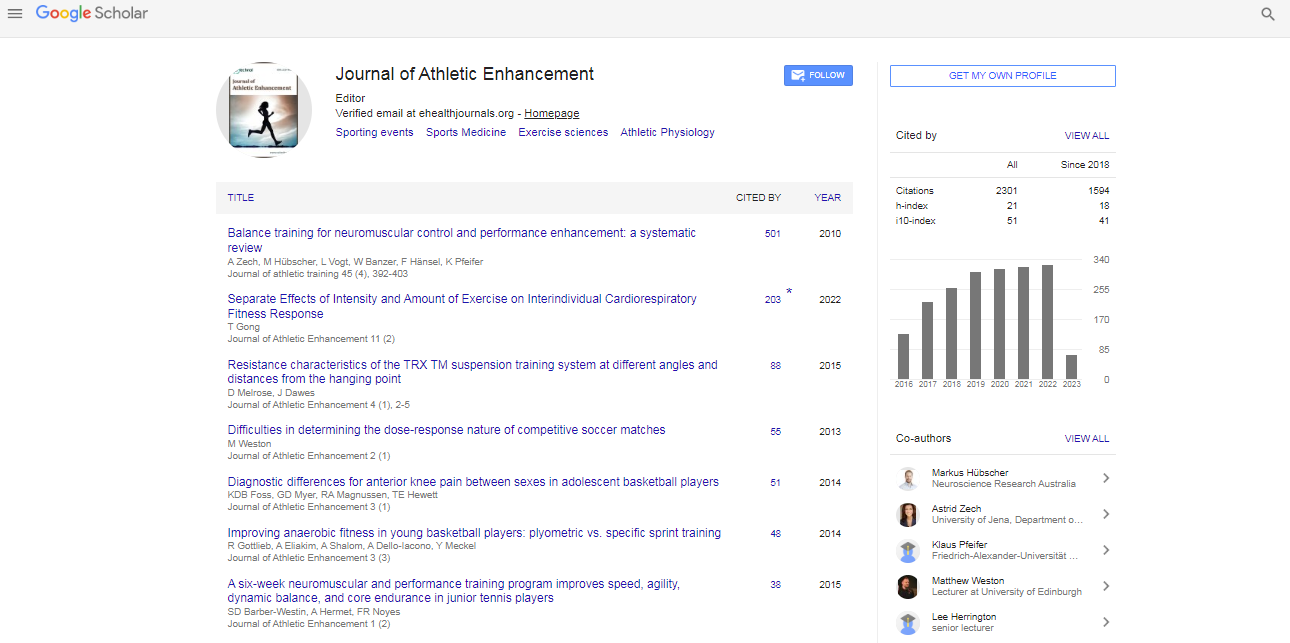Commentary, J Athl Enhanc Vol: 13 Issue: 2
Maximizing Athletic Performance: The Art and Science of Athletic Training
Melinda Susan*
1Department of Sports, AERES University of Applied Sciences Almere, Almere, Netherlands
*Corresponding Author: Melinda Susan,
Department of Sports, AERES
University of Applied Sciences Almere, Almere, Netherlands
E-mail: susanmelinda@edu.nl
Received date: 26 February, 2024, Manuscript No. JAE-24-134567;
Editor assigned date: 29 February, 2024, PreQC No. JAE-24-134567 (PQ);
Reviewed date: 14 March, 2024, QC No. JAE-24-134567;
Revised date: 21 March, 2024, Manuscript No. JAE-24-134567 (R);
Published date: 28 March, 2024, DOI: 10.4172/2324-9080.1000117
Citation: Susan M (2024) Maximizing Athletic Performance: The Art and Science of Athletic Training. J Athl Enhance 13:2.
Description
Athletic training stands at the nexus of human potential and physical performance, blending science, strategy, and sweat to elevate athletes to their peak capabilities. It encompasses a multifaceted approach, encompassing physical conditioning, mental resilience, skill development, and injury prevention. As sports evolve and competition intensifies, the demands on athletes have never been higher, necessitating sophisticated training methodologies to optimize performance and minimize the risk of injury.
At its core, athletic training aims to enhance the physiological capacities and skill sets required for athletic endeavors. This begins with a comprehensive assessment of an athlete's baseline abilities, including strength, speed, agility, endurance, and flexibility. Understanding individual strengths and weaknesses is essential for tailoring training programs to maximize improvement while mitigating the risk of injury.
Periodization, a fundamental concept in athletic training, involves breaking down the training process into distinct phases, each with specific objectives and intensities. This strategic approach ensures that athletes peak at the right time, aligning their training regimen with competition schedules and optimizing performance during key events.
Strength and conditioning form the cornerstone of athletic performance, underpinning speed, power, and resilience. Traditional resistance training, supplemented by innovative techniques such as plyometric, functional movement training, and High-Intensity Interval Training (HIIT), cultivates the explosive strength and endurance required for success across various sports.
Fuelling the body for optimal performance is as crucial as the training itself. Proper nutrition supports muscle growth, facilitates recovery, and sustains energy levels during training and competition. Athletic nutritionists collaborate with athletes to develop personalized dietary plans, emphasizing macronutrient balance, hydration strategies, and timing of meals to optimize performance and recovery.
The mind is a potent force in athletic achievement, influencing focus, confidence, and resilience in the face of adversity. Mental conditioning techniques, including visualization, goal setting, mindfulness, and sports psychology interventions, empower athletes to harness their full potential and overcome performance barriers. Cultivating a strong mental game is often the differentiating factor in high-stakes competitions where physical abilities alone may not suffice.
Athletic prowess extends beyond raw physical attributes to encompass technical proficiency and tactical acumen. Skill development drills, repetition, and game-specific simulations refine technique, enhance decision-making, and foster a deep understanding of the nuances within each sport. Coaches play a pivotal role in orchestrating structured skill development programs tailored to the unique demands of individual athletes and their respective disciplines.
The pursuit of athletic excellence is not without risks, as the repetitive stress and high-impact nature of sports predispose athletes to injury. Injury prevention strategies, including proper warm-up routines, biomechanical analysis, and targeted strengthening exercises, aim to fortify vulnerable areas and mitigate the risk of common injuries.
Despite preventive measures, injuries may still occur, necessitating prompt and effective rehabilitation protocols. Rehabilitation specialists employ a multidisciplinary approach, incorporating physical therapy, strength training, manual therapy, and innovative modalities such as cryotherapy and hydrotherapy to expedite recovery and restore athletes to peak condition.
The landscape of athletic training continues to evolve, driven by advancements in technology and sports science. Wearable devices, such as GPS trackers, accelerometers, and heart rate monitors, provide real-time data on athletes' performance metrics, enabling coaches to optimize training loads, monitor fatigue levels, and minimize injury risk.
Virtual Reality (VR) and Augmented Reality (AR) technologies offer immersive training experiences, allowing athletes to simulate game scenarios, enhance decision-making skills, and refine spatial awareness in a controlled environment. Biomechanical analysis tools, including motion capture systems and force plates, provide invaluable insights into movement mechanics, facilitating precision in technique refinement and injury prevention strategies.
Athletic training represents a dynamic fusion of art and science, where empirical knowledge intersects with innovation to elevate human performance to unprecedented heights. As athletes continue to push the boundaries of what is possible, the pursuit of excellence in athletic training remains an on-going journey of discovery and refinement. By embracing the latest methodologies, harnessing cutting-edge technologies, and prioritizing holistic athlete development, coaches and practitioners can unlock the full potential of athletes and shape the future of sports performance.
 Spanish
Spanish  Chinese
Chinese  Russian
Russian  German
German  French
French  Japanese
Japanese  Portuguese
Portuguese  Hindi
Hindi 
